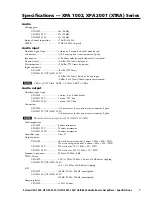
L-ACOUSTICS V-DOSC Manual Version 4
6/29/2005
Page 66 of 158
Variable Curvature V-DOSC Array
Since individual V-DOSC enclosures radiate a flat, isophasic wavefront it is possible to focus energy in
a given direction and increase the SPL by reducing the angles between enclosures. Conversely, by
increasing the angle between enclosures (up to a maximum of 5.5°) it is possible to lower the SPL in
another direction. This is the basic principle that allows energy to be distributed uniformly throughout
the audience and variable curvature arrays are used to adapt both the coverage of the system and the
SPL distribution to match the specific audience geometry according to WST Condition #4.
Shaping the VERTICAL ISOCONTOUR is the key to Wavefront Sculpture Technology.
SOUNDVISION and ARRAY 2004 simulation programs allow the designer to shape the vertical
isocontour of a V-DOSC array. The following sections give more complete details on variable
curvature array design.
2.3 V-DOSC COVERAGE MODELING USING ARRAY 2004
L-ACOUSTICS has developed a fast, easy-to-use prediction spreadsheet named ARRAY 2004 that
operates under Microsoft Excel. ARRAY 2004 can predict coverage for flat, constant curvature or
variable curvature V-DOSC arrays.
The first four worksheets represent vertical cut views (section elevations) of the audience in the XZ
plane and show a pseudo-3D representation of the intersection of the site angles for each enclosure
with the audience (these intersections are termed enclosure site angle impacts). The direction of each
enclosure is calculated according to the user-input angles. All angles are referenced with respect to
the site angle of the top enclosure which should be aimed at the rearmost part of the audience.
Cutview sheets are used to shape the vertical isocontour of either V-DOSC or dV-DOSC arrays to
match the audience area.
Note: Cutview sheets V-ARRAY1 and V-ARRAY are used to simulate V-DOSC arrays (including dV-DOSC
upfill and/or downfill enclosures) while Cutview sheets dV-ARRAY1 and dV-ARRAY2 are used for dV-DOSC.
The H-ISOCONT sheet displays the horizontal isocontour (see Section 2.1) of all defined arrays
projected onto a plan view of the audience area in the XY plane.
The SUB ARC sheet is used to calculate delay taps based on the physical configuration of a given
subwoofer array for electronic arc processing (see Section 3.4)
The MTD XT SPACING sheet can be used to help calculate optimum spacing for a given throw
distance for distributed sound reinforcement using MTD or XT coaxial loudspeakers.
The ROOM DIM sheet can be used to help calculate XZ cutview parameters based on room
measurements. Room dimension calculation utilities are also available in the V-ARRAY1, V-ARRAY2,
dV-ARRAY1 and dV-ARRAY2 sheets.
In general, all input data should be entered into the cells in black. Results are displayed in red.
Note: In order to run ARRAY, Macro Security should be set at “medium” in Excel, i.e., from the main menu
bar select: Tools / Macro / Security / Security Level = Medium
Note: A complete description of ARRAY2004 is beyond the scope of this manual. For further information,
participation in a V-DOSC Training Seminar is recommended.
Summary of Contents for V-DOSC
Page 1: ...Version 4 June 2005 V DOSC OPERATOR MANUAL ...
Page 2: ...L ACOUSTICS V DOSC Manual Version 4 6 29 2005 Page 2 of 158 ...
Page 116: ...L ACOUSTICS V DOSC Manual Version 4 6 29 2005 Page 116 of 158 a b c d e f g h ...
Page 117: ...L ACOUSTICS V DOSC Manual Version 4 6 29 2005 Page 117 of 158 i j k l m n o p ...
Page 118: ...L ACOUSTICS V DOSC Manual Version 4 6 29 2005 Page 118 of 158 q r s t u v w x ...
Page 156: ...L ACOUSTICS V DOSC Manual Version 4 6 29 2005 Page 156 of 158 ...
Page 157: ...L ACOUSTICS V DOSC Manual Version 4 6 29 2005 Page 157 of 158 ...
Page 158: ...L ACOUSTICS V DOSC Manual Version 4 6 29 2005 Page 158 of 158 ...
















































